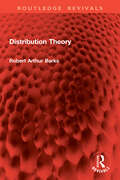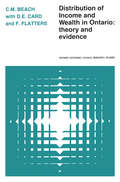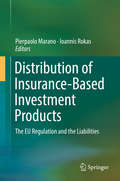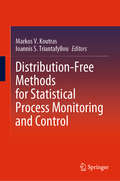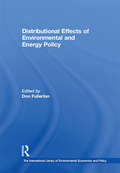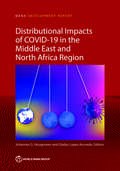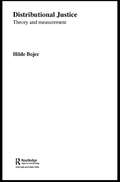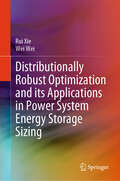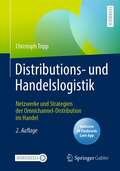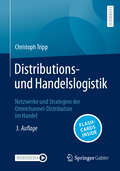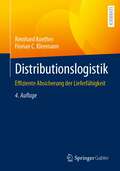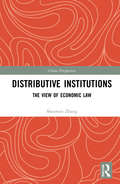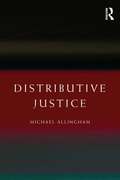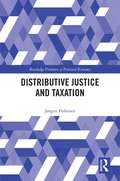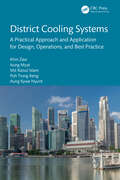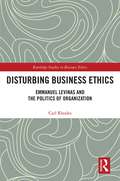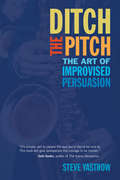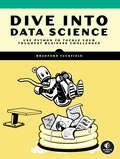- Table View
- List View
Distribution Theory (Routledge Revivals)
by Robert Arthur BarksFirst published in 1972, Distribution Theory follows on from the author's earlier book, Descriptive Statistics and Probability Theory, but may easily be followed by any reader who has not studied that particular book but who has gained some knowledge of numerical distributions and basic probability theory. The author has attempted to steer a middle course between those textbooks which concentrate solely on statistical calculations and those which concentrate solely on statistical theory. It is his belief that statistics is best understood through a mixture of practical numerical work and knowledge of the corresponding theory.In this book, probability distributions are shown to develop out of different physical situations that are commonly met in the physical world. The three most commonly used- the binomial, Poisson, and normal distributions- are dealt in detail, but other less commonly used distributions are also introduced. By showing the different situations to which these distributions apply, their individuality is emphasised. The author then illustrates how these probability distributions are used in sampling theory. The book concludes with a chapter which shows how apparently different parts of statistics can be seen to interrelate through statistical theory. This is an interesting reference work for students of mathematics, statistics and economics.
Distribution at American Airlines (C)
by Benjamin EdelmanPresents 2011-2012 updates to American's distribution strategy including new challenges and disputes. [Supplement for case 909035]
Distribution of Income and Wealth in Ontario: Theory and Evidence
by Charles M. Beach David E. Card Frank FlattersDistribution analysis has advanced remarkably in recent years, and this is a valuable application of its principles to a Canadian context. The book provides an extensive survey of recent literature and a new source of income and wealth distribution data for Ontario, drawn from newly available microdata sets. It also presents an evaluation of the data as a basis for measuring inequality in the distribution of economic and well-being.The empirical results illustrate how incomes vary significantly with age according to labour market attachment and experience, educational attainment and occupation, transfer receipts, and investment benefits. Similarly, strong age effects on net worth account reflect life-cycle patterns in asset holdings and debts typically associated with family investment in housing and financial adjustments for retirement. Differences in family size and composition have a substantial effect on the structure of family economic well-being. The inequality effects of adjusting for accrued capital gains and net worth holdings can also be quite significant. It is found that the distributional effects of CPP net benefits are considerable, although they are not as equalizing as one may have expected because of marked cohort effects. The detailed findings suggest that the life-cycle framework is a very useful one for evaluating the distributional effects of certain government programs, particularly intertemporal ones, and they underline the need for a range of different types of policies to address low income problems. The study urges greater recognition of the inequality of treatment and opportunity among different groups of the population. It also points out that conventional income distribution figures are only very imperfect estimates of the state of inequality in the underlying distribution of economic well-being.
Distribution of Insurance-Based Investment Products: The EU Regulation and the Liabilities
by Pierpaolo Marano Ioannis RokasThe book addresses a topic at the intersection of two heavily regulated sectors: insurance and investment services. Until recently, scholars and professionals have approached insurance and investment services as two separate categories in the financial services sector, and as being governed by separate regulatory frameworks. In practice, however, the boundaries were and are blurred, a reality that regulators have begun to recognize and address in their more recent regulatory texts. The first part of the book approaches the new standards applicable to investment products based on insurance: insurance-based investment products (IBIPs). These rules are harmonized across the EU. The rationale behind this new definition is provided, together with a description of these products’ limitations. The analysis addresses the new rules and explores the legal regime and relevant standards applicable to IBIPs. The organizational rules concerning the design and distribution of IBIPs are also examined, and the book highlights e.g. how these rules are inspired by the principles of conduct. In closing, the ADR systems are analysed, in order to ascertain whether or not they can offer an effective tool for settling disputes over these products. In turn, the second part focuses on the liability for distribution of IBIPs, which ranks as one of the most conspicuous and relatively new legal phenomena, but at the same time, represents an exceptionally important field of civil liability in today’s world. Liability is still regulated at the national level. Thus, the four largest life insurance markets in the EU are considered, along with the largest emerging market for life insurance. The chapters on national laws also consider whether, and if so, how the new harmonized rules on IBIPs are being combined with those already in force in the jurisdictions considered. The goal is to determine whether the new rules are likely to change the doctrine and case law approach to these products, or whether the European legislators’ choices have no real impact on the protection of clients.
Distribution-Free Methods for Statistical Process Monitoring and Control
by Markos V. Koutras Ioannis S. TriantafyllouThis book explores nonparametric statistical process control. It provides an up-to-date overview of nonparametric Shewhart-type univariate control charts, and reviews the recent literature on nonparametric charts, particularly multivariate schemes. Further, it discusses observations tied to the monitored population quantile, focusing on the Shewhart Sign chart. The book also addresses the issue of practically assuming the normality and the independence when a process is statistically monitored, and examines in detail change-point analysis-based distribution-free control charts designed for Phase I applications. Moreover, it introduces six distribution-free EWMA schemes for simultaneously monitoring the location and scale parameters of a univariate continuous process, and establishes two nonparametric Shewhart-type control charts based on order statistics with signaling runs-type rules. Lastly, the book proposes novel and effective method for early disease detection.
Distribution: Changing Times-Winning in China
by Jonathan Woetzel Jimmy HexterGetting products to new markets in China efficiently and cost-effectively is probably the most perplexing challenge multinational companies face as they expand from the big eastern cities into wider circles of smaller-tier cities. Getting the right distribution and sales operating model in place is a critical determinant of success.
Distributional Effects of Environmental and Energy Policy (The International Library of Environmental Economics and Policy)
by Don FullertonMany effects of environmental and energy policy are likely to disproportionately burden those with low income. First, it raises the price of fossil-fuel-intensive products that constitute a high fraction of low-income budgets (like gasoline, heating fuel and electricity). Second, the handout of pollution permits to firms provides value to those who own them. Third, low-income individuals may place more value on food and shelter than on improvements in environmental quality, so high-income individuals may get the most benefit of pollution abatement. Fourth, air quality improvements may raise the value of houses owned by landlords, rather than helping renters. These effects might all hurt the poor more than the rich. This book brings together the seminal economics literature that studies whether these fears are valid and whether anything can be done about them.
Distributional Impacts of COVID-19 in the Middle East and North Africa Region (MENA Development Report)
by Johannes G. Hoogeveen Gladys Lopez-AcevedoCOVID-19 is one of multiple crises to have hit the Middle East and North Africa (MENA) region in the decade following the Arab Spring. War, oil price declines, economic slowdowns, and now a pandemic are tearing at the social fabric of a region characterized by high rates of unemployment, high levels of informality, and low annual economic growth. The economic costs of the pandemic are estimated at about US$227 billion, and fiscal support packages across MENA are averaging 2.7 percent of GDP, putting pressure on already weak fiscal balances and making a quick recovery challenging. Even before the COVID-19 pandemic, MENA was the only region in the world experiencing increases in poverty and declines in life satisfaction. Distributional Impacts of COVID-19 in the Middle East and North Africa Region investigates how COVID-19 changed the welfare of individuals and households in the region. It does so by relying on phone surveys implemented across the region and complements these with microsimulation exercises to assess the impact of COVID-19 on jobs, income, poverty, and inequality. The two approaches complement and corroborate each other's results, thereby making the findings more robust and richer. This report's results show that, in the short run, poverty rates in MENA will increase significantly and inequality will widen. A group of 'new poor' is likely to emerge that may have difficulty recovering from the economic consequences of COVID-19. The report adds value by analyzing newly gathered primary data, along with projections based on newly modeled micro- and macrosimulations, and by identifying key issues that policy makers should focus on to enable a quick, inclusive, and sustained economic recovery.
Distributional Justice: Theory and Measurement (Routledge Frontiers of Political Economy #Vol. 47)
by Hilde BojerIntroducing the main theories of distributional justice the book covers utilitarianism and welfare economics, moving on to Rawls's social contract and the Sen/Nussbaum capability approach with a refreshingly readable style. There is a chapter covering the position of mothers and children in theories of justice. The book then studies empirical methods used in analysing the distribution of economic goods, covering Lorenz curves and inequality measures. The concepts of income, wealth and economic goods are comprehensively discussed, with a particular view to their role in theories of justice. This book is an important read for economists and other social scientists, as well as philosophers who want to quantify social and economic justice.
Distributionally Robust Optimization and its Applications in Power System Energy Storage Sizing
by Wei Wei Rui XieThis book introduces the mathematical foundations of distributionally robust optimization (DRO) for decision-making problems with ambiguous uncertainties and applies them to tackle the critical challenge of energy storage sizing in renewable-integrated power systems, providing readers with an efficient and reliable approach to analyze and design real-world energy systems with uncertainties. Covering a diverse range of topics, this book starts by exploring the necessity for energy storage in evolving power systems and examining the benefits of employing distributionally robust optimization. Subsequently, the cutting-edge mathematical theory of distributionally robust optimization is presented, including both the general theory and moment-based, KL-divergence, and Wasserstein-metric distributionally robust optimization theories. The techniques are then applied to various practical energy storage sizing scenarios, such as stand-alone microgrids, large-scale renewable power plants, bulk power grids, and multi-carrier energy networks. This book offers clear explanations and accessible guidance to bridge the gap between advanced optimization methods and industrial applications. Its interdisciplinary scope makes the book appealing to researchers, graduate students, and industry professionals working in electrical engineering and operations research, catering to both beginners and experts.
Distributions- und Handelslogistik: Netzwerke Und Strategien Der Omnichannel-distribution Im Handel
by Christoph TrippDieses Buch zeigt die wichtige Rolle der Distributions- und Handelslogistik vor dem Hintergrund des zunehmenden Einflusses der Digitalisierung auf Prozesse, Strukturen und Systeme in den logistischen Netzwerken der Konsumgüterwirtschaft. Durch die besondere Transportintensität, die Lagerkomplexität und erhebliche Flexibilitätsanforderungen in der Auftragsabwicklung entstehen hohe Logistikkosten. Andererseits steigen die Serviceanforderungen der Kunden durch den wachsenden Onlinehandel. Für Händler ergibt sich in der Distributionslogistik ein Zielkonflikt aus notwendigen Kostenoptimierungen und kundenseitig erwarteten Serviceerweiterungen. Anhand von zahlreichen Praxisbeispielen wird anschaulich beschrieben, wie sich die Distributionssysteme von Unternehmen verändern müssen, um den Anforderungen des Multi- bzw. Omnichannel-Handels gerecht werden zu können. Lernziele und Kontrollfragen zu jedem Kapitel ergänzen die Ausführungen und ermöglichen eine optimale Prüfungsvorbereitung.
Distributions- und Handelslogistik: Netzwerke und Strategien der Omnichannel-Distribution im Handel
by Christoph TrippDieses Buch zeigt die wichtige Rolle und Systemrelevanz der Distributions- und Handelslogistik vor dem Hintergrund des zunehmenden Einflusses der Digitalisierung und der Nachhaltigkeit auf Prozesse, Strukturen und Systeme in den logistischen Netzwerken der Konsumgüterwirtschaft. Durch die besondere Transportintensität, die Lagerkomplexität und erhebliche Flexibilitätsanforderungen in der Auftragsabwicklung entstehen hohe Logistikkosten. Andererseits steigen die Serviceanforderungen der Kunden durch den wachsenden Onlinehandel. Für Händler ergibt sich in der Distributionslogistik ein Zielkonflikt aus notwendigen Kostenoptimierungen und kundenseitig erwarteten Serviceerweiterungen.Anhand von zahlreichen Praxisbeispielen wird anschaulich beschrieben, wie sich die Distributionssysteme von Unternehmen verändern müssen, um den Anforderungen des Omnichannel-Handels gerecht werden zu können. Lernziele und Kontrollfragen zu jedem Kapitel ergänzen die Ausführungen und ermöglichen eine optimale Prüfungsvorbereitung.In der 2. Auflage wurden umfangreiche Aktualisierungen und Überarbeitungen vorgenommen sowie zusätzliche Praxisbeispiele ergänzt. In Konsequenz der globalen Ereignisse in den vergangenen Jahren nehmen Technologien, Convenience-Erwartungen, Adaptivitäts- und Resilienzanforderungen sowie ökologische und soziale Nachhaltigkeit eine noch stärkere Rolle im Rahmen dieser Auflage ein.Zusatznutzen: Laden Sie die Springer Nature Flashcards-App mit insgesamt 220 Fragen kostenlos herunter und überprüfen Sie Ihr Wissen.
Distributions- und Handelslogistik: Netzwerke und Strategien der Omnichannel-Distribution im Handel
by Christoph TrippDieses Buch zeigt die wichtige Rolle und Systemrelevanz der Distributions- und Handelslogistik vor dem Hintergrund des zunehmenden Einflusses von Convenience, Digitalisierung, Nachhaltigkeit und Resilienz auf Prozesse, Strukturen und Systeme in den Logistiknetzwerken des Handels. Daraus ergibt sich ein immer herausfordernder Zielkonflikt aus notwendigen Kostenoptimierungen und kundenseitig erwarteten Serviceerweiterungen. Mit der dritten Auflage liegt eine völlig überarbeitete und erweiterte Ausgabe des Buches vor, die 125 Abbildungen, 22 Tabellen sowie hunderte Praxis- und Fallbeispiele enthält. Sie trägt vor allem den sich wandelnden globalen Geschäftsmodellen im Handel Rechnung, indem ein stärkerer Fokus auf internationale Beispiele, vor allem aus den USA und China, gelegt wird. Zudem bedingen die zunehmende Vermischung von Einzel- und Großhandelskonzepten und die hohe Relevanz des Onlinehandels sowie des Lieferservices in Großhandelsunternehmen eine verstärkte Berücksichtigung von Beispielen aus dem B2B-Handel. Zusatznutzen: Laden Sie die Springer Nature Flashcards-App mit insgesamt 222 Fragen und Antworten kostenlos herunter und überprüfen Sie Ihr Wissen.
Distributionslogistik: Effiziente Absicherung der Lieferfähigkeit
by Reinhard Koether Florian C. KleemannDieses Buch beschreibt anschaulich die verschiedenen Aspekte der Distributionslogistik und zeigt anhand zahlreicher Beispiele leistungsfähiger Distributionslogistik, wie Unternehmen den vorgestellten Methodenbaukasten als Wettbewerbsvorteil nutzen können. Nur wer liefern kann, macht das Geschäft. Diese alte Kaufmannsregel ist die Kernaufgabe der Distributionslogistik: Sicherzustellen, dass die Kunden die bestellten Waren rechtzeitig, sicher und in guter Qualität erhalten. Der Verkäufer muss darauf achten, dass auch die Bestands- und Transportkosten stimmen. Mit der Leistungsfähigkeit moderner Distributionslogistik werden die Kunden anspruchsvoller, d. h. alle Produkte sollen in der gewünschten Form überall, schnell und preisgünstig verfügbar sein. In der 4. Auflage wurden die Inhalte und Daten überarbeitet und an die aktuellen Entwicklungen angepasst.
Distributionslogistik: Effiziente Absicherung der Lieferfähigkeit
by Reinhard KoetherDieses Buch beschreibt anschaulich die verschiedenen Aspekte der Distributionslogistik und zeigt anhand zahlreicher Beispiele leistungsfähiger Distributionslogistik, wie Unternehmen den vorgestellten Methodenbaukasten als Wettbewerbsvorteil nutzen können. Nur wer liefern kann, macht das Geschäft. Diese alte Kaufmannsregel ist die Kernaufgabe der Distributionslogistik: Sicherzustellen, dass die Kunden die bestellten Waren rechtzeitig, sicher und in guter Qualität erhalten. Der Verkäufer muss darauf achten, dass auch die Bestands- und Transportkosten stimmen. Mit der Leistungsfähigkeit moderner Distributionslogistik werden die Kunden anspruchsvoller, d. h. alle Produkte sollen in der gewünschten Form überall, schnell und preisgünstig verfügbar sein.
Distributionslogistik: Effiziente Absicherung der Lieferfähigkeit
by Reinhard KoetherNur wer liefern kann, macht das Geschäft. Diese alte Kaufmannsregel ist die Kernaufgabe der Distributionslogistik: Sicherzustellen, dass die Kunden die bestellten Waren rechtzeitig, sicher und in guter Qualität erhalten. Der Verkäufer muss darauf achten, dass auch die Bestands- und Transportkosten stimmen. Mit der Leistungsfähigkeit moderner Distributionslogistik werden die Kunden anspruchsvoller, d. h. alle Produkte sollen in der gewünschten Form überall, schnell und preisgünstig verfügbar sein. Dieses Buch beschreibt anschaulich die verschiedenen Aspekte der Distributionslogistik und zeigt anhand zahlreicher Beispiele leistungsfähiger Distributionslogistik, wie Unternehmen den vorgestellten Methodenbaukasten als Wettbewerbsvorteil nutzen können.
Distributive Institutions: The View of Economic Law (China Perspectives)
by Shouwen ZhangThe crisis of distribution is one of the longest standing and most complicated issues facing human society. Imbued with social, political, historic, and cultural elements, it varies significantly across different countries as a result of all these factors. As an emerging economy which transferred from a planned to a market economy, China has experienced large distribution gaps since it implemented the Reform and Opening-up Policy in the early 1980s, requiring stronger economic law to mitigate and regulate the crisis of distribution. In this second volume, the author analyses crises of distribution from a theoretical perspective and proposes law and policy solutions. Believing that such crises are a collective result of systematic limitations, the author proposes a theoretical framework of “system–distribution–development” in order to resolve distribution problems and promote economic development. He argues that a crisis of distribution cannot be avoided without coordinated development of economic law and relevant constitutional, civil, and commercial law systems. In addition, it is necessary to differentiate the territories, industries, enterprises, and individuals that constitute such diverse systems. The book should be of keen interest to researchers and students of law, economics, and political science.
Distributive Justice
by Michael AllinghamThis book presents a critical appraisal of the main theories of distributive justice. It develops the view that all such theories, or at least all liberal theories, may be seen as expressions of laissez-faire with compensations for factors that they consider to be morally arbitrary. More precisely, these theories are interpreted as specifying that the outcome of individuals acting independently, without the intervention of any central authority, is just, provided that those who fare ill for reasons that the theories deem to be arbitrary, for example, because they have fewer talents than others, receive compensation from those who fare well. The principal theories discussed are Rawls’s justice as fairness, Dworkin’s equality of resources, what may loosely be called Steiner-Vallentyne common ownership theories, and Nozick’s entitlements theory. The book considers the extent, if any, to which the theories examined can accommodate both liberty and equality. It concludes that if any such accommodation is possible it will be found in common ownership theories.
Distributive Justice and Taxation (Routledge Frontiers of Political Economy)
by Jørgen PedersenProviding a thorough examination of distributive justice, Distributive Justice and Taxation presents and discusses different theories of what constitutes a just society, and how goods should be distributed in such a society. The distribution of goods in society has direct and serious consequences on the lives of the people. There are therefore important questions to be asked regarding the justice of that distribution: Is it just that some people inherit large fortunes while others inherit nothing? Do rich people have additional access to political power because of their wealth? If so, is that just? And should the ambition for economic policies be to combat poverty, or to reduce inequality? This book explores these questions and a number of others through the analysis of related theories, spanning from strong egalitarian theories on the left to right-wing libertarianism. The chapters also explicitly examine the case of taxation – one of the most important and controversial measures of distribution of goods in society. Placing emphasis on the case of Norway and using data from both the UK and USA as a point of comparison, the work details and explores the key features of the tax system. It concludes by presenting and evaluating arguments for and against taxes such as income tax, wealth tax, and inheritance tax. This book is essential reading for those interested in distributive justice, as well as students and scholars of philosophy, law, political science, and economics.
District Cooling Systems: A Practical Approach and Application for Design, Operations, and Best Practice
by Aung Myat Md Raisul Islam Khin Zaw Poh Tiong Keng Aung Kywe NyuntThis book draws on the authors’ industry and academic expertise to explain the theory and practice of district cooling systems (DCS). The in-depth exploration of the design and development of DCS presents detailed best practices for their optimization in both the development and operation phases.Readers will gain in-depth practical knowledge on all areas and considerations related to DCS technology's best practices, including current practical research areas and future potential research areas. This book addresses five areas related to DCS: the fundamentals of DCS technology, design optimization for development purposes, real-time optimization for daily operations, techno-commercial decision-making framework, and industry best practice. This information is presented through analyses of technological progress to date; case studies of current operations; and in-depth discussions of the theoretical bases and commercial, technical, and environmental benefits. Through this book, readers can recognize and apply best practices for the design, development, and operation of an optimal DCS design based on multiple factors including financial analysis, energy efficiency considerations, and practical operation issues. This will enable them to contribute to national and international sustainable development goals regarding sustainable cities and climate action.As this book provides both industry know-how and future research directions related to DCS, it is invaluable for DCS industry professionals and advanced undergraduate and postgraduate engineering students who aim to enter this industry and develop leading, highly efficient DCS systems. Overall, it is a vital resource for anyone involved in the planning, execution, and management of DCS projects.
District Cooling: Theory and Practice (Heat Transfer #7)
by Alaa A. OlamaDISTRICT COOLING: THEORY and PRACTICE provides a unique study of an energy cogeneration system, set up to bring chilled water to buildings (offices, apartment houses, and factories) needing cooling for air conditioning and refrigeration. In winter, the source for the cooling can often be sea water, so it is a cheaper resource than using electricity to run compressors for cooling. The related technology of District Heating has been an established engineering practice for many years, but District Cooling is a relatively new technology now being implemented in various parts of the world, including the USA, Arab Emirates and Kuwait, and Saudi Arabia. Existing books in the area are scarce, and do not address many of the crucial issues facing nations with high overall air temperatures, many of which are developing District Cooling plans using sea water. DISTRICT COOLING: THEORY & PRACTICE integrates the theory behind district cooling planning with the practical engineering approaches, so it can serve the policy makers, engineers, and planners whose efforts have to be coordinated and closely managed to make such systems effective and affordable. In times of rising worldwide temperatures, District Cooling is a way to provide needed cooling with energy conservation and sustainability. This book will be the most up-to-date and comprehensive study on the subject, with Case Studies describing real projects in detail.
Disturbing Business Ethics: Emmanuel Levinas and the Politics of Organization (Routledge Studies in Business Ethics)
by Carl Rhodes21st century Western neoliberalism has seen the transformation of self-interest from an economic imperative to a centrally constitutive part of dominant modes of subjective existence. Against this celebration of competitive individualism, Emmanuel Levinas’ philosophy stands as a haunting reminder of an ethics that passively disturbs the self from its egoistic slumber, awakening it to the incessant demands of the other. Ethics stands as an anxious affective state of being where one is held to account by others, each one demanding care, attention and respect. Focussing on business activities and organizations, this book explores how this ethical demand of being for the other becomes translated, in a necessarily impure way, into political action, contestation and resistance. Such a response to ethics invokes a disturbance of organizational order, including an order that might itself be labelled ‘ethical’. On these grounds, the book offers an explication of an ethics for organizations which disturbs the selfishness of neoliberal morality, and can inform a democratic politics rested on a genuine concern for the other and for justice. Disturbing Business Ethics: Emmanuel Levinas and the Politics of Organization offers an unconventional and enlightening approach to ethical thinking and practice in politics and organisations, and will be of interest to students of business, management, leadership, political science and organizational theory.
Ditch the Pitch
by Steve YastrowIn today's world, customers don't want to hear sales pitches, but so many salespeople still rely on them. In his breakthrough handbook, Ditch the Pitch, Steve Yastrow, founder of a successful business strategy consulting firm, asks us to throw out everything we've been taught about pitching to customers. Steve's advice: tear up your sales pitch and instead improvise persuasive conversations. Ditch the Pitch is an essential read for salespeople, business managers, and anyone wishing to persuade those around them. Organized into six habits, with each habit consisting of three practices necessary for mastery, Ditch the Pitch is designed to teach Yastrow's approach to fresh, spontaneous, persuasive conversations. These new skills will show the reader how to identify the details that make each customer unique and subsequently navigate a conversation that focuses on the right message for the right customer at the right time. Throughout the book, the author quotes well-known improv comedians and musicians. He translates the techniques these artists use when improvising to create persuasive situations with customers. With the new confidence Ditch the Pitch offers, you will become master of the art of on-the-spot, engaging, and effective customer interactions. Let go of pre-written scripts and embrace Yastrow's guidelines for effortlessly enabling spontaneous conversations that persuade customers to say "yes. "
Ditch the Pitch: The Art of Improvised Persuasion
by Steve YastrowIn today's world, customers don't want to hear sales pitches, but so many salespeople still rely on them. In his breakthrough handbook, Ditch the Pitch, Steve Yastrow, founder of a successful business strategy consulting firm, asks us to throw out everything we've been taught about pitching to customers. Steve's advice: tear up your sales pitch and instead improvise persuasive conversations. Ditch the Pitch is an essential read for salespeople, business managers, and anyone wishing to persuade those around them. Organized into six habits, with each habit consisting of three practices necessary for mastery, Ditch the Pitch is designed to teach Yastrow's approach to fresh, spontaneous, persuasive conversations. These new skills will show the reader how to identify the details that make each customer unique and subsequently navigate a conversation that focuses on the right message for the right customer at the right time.
Dive Into Data Science: Use Python To Tackle Your Toughest Business Challenges
by Bradford TuckfieldLearn how to use data science and Python to solve everyday business problems.Dive into the exciting world of data science with this practical introduction. Packed with essential skills and useful examples, Dive Into Data Science will show you how to obtain, analyze, and visualize data so you can leverage its power to solve common business challenges.With only a basic understanding of Python and high school math, you&’ll be able to effortlessly work through the book and start implementing data science in your day-to-day work. From improving a bike sharing company to extracting data from websites and creating recommendation systems, you&’ll discover how to find and use data-driven solutions to make business decisions.Topics covered include conducting exploratory data analysis, running A/B tests, performing binary classification using logistic regression models, and using machine learning algorithms.You&’ll also learn how to:Forecast consumer demand Optimize marketing campaignsReduce customer attritionPredict website trafficBuild recommendation systemsWith this practical guide at your fingertips, harness the power of programming, mathematical theory, and good old common sense to find data-driven solutions that make a difference. Don&’t wait; dive right in!
